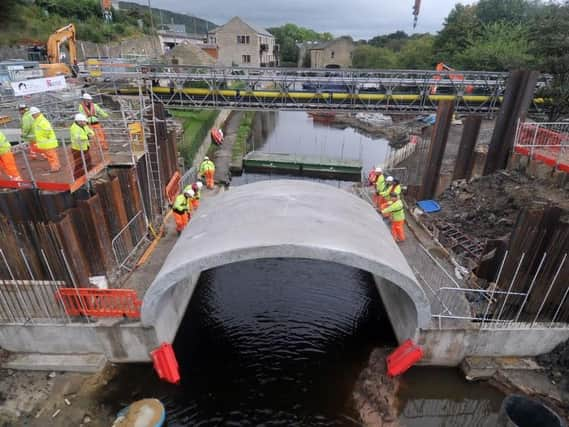Yorkshire's flood-hit communities like Calderdale are better protected than ever - Sir James Bevan


It’s not easy to bring hugely complex, multi-year projects in on time and on budget.
So forgive me, but I am going to pay tribute to the achievement of teams across the Environment Agency who have worked hand-in-hand with local authorities, drainage boards, government and the private sector across the country over the last six years, to better protect more than 300,000 homes and businesses from floods.
Advertisement
Hide AdAdvertisement
Hide AdThis may seem like an abstract number, but for flood-hit communities, the brand-new Ipswich and Boston barriers or the multi-million pound flood and sea defences in Burton-on-Trent and Hull mean absolutely everything.
For many people these defences are the difference between being flooded out, and suffering mental turmoil and misery, or staying put and escaping with their homes and businesses intact.
We know these schemes are working. Whilst it was completely devastating for the 600 or so households that suffered from Storm Christoph back in January, imagine the impact if that figure had been more like the 49,000 properties that were saved by flood schemes.
Towns in the Calder Valley, for example, could have been flooded yet again. However, up on the moors around the valley, peatland restoration projects, that we have championed, are not only locking up carbon for decades to come, but retaining vast quantities of water and slow the flow when major downpours happen.
Advertisement
Hide AdAdvertisement
Hide AdAfter the miserable floods in 2015 affecting places like Mytholmroyd, we prioritised improved defences and last year completed a £41 million scheme that not only better protects 400 properties in the village, but also local schools, infrastructure and amenities.
In towns like Hebden Bridge, where the Calder meanders through its centre, a scheme sensitive to the beauty, history and economy of the area is being designed to better protect 200 local businesses and 186 homes and reduce the risk of major flooding from 20 per cent to 2 per cent in any given year.
And while the Calder Valley is now better protected from river flooding than ever before, communities on the other side of Yorkshire are also safeguarded from a different threat.
The people of Hull have lived with the threat of tidal flooding from the North Sea for generations, with three major tidal events hitting the city in the past 65 years.
Advertisement
Hide AdAdvertisement
Hide AdSuch is the power of nature that we can never eliminate that threat completely, but our £42 million upgrade of more than seven kilometres of defences along the estuary will reduce the risk of flooding for 113,000 properties.
We have also worked in partnership with Yorkshire’s major cities and economic hubs.
In partnership with Leeds City Council, more than £122 million was invested in flood defences for Leeds, offering better protection for homes, businesses and infrastructure which were hit in 2015.
Likewise in Sheffield, schemes protecting 276 homes, 665 businesses, and 19,000 jobs along the River Loxley in Hillsborough have been installed.
Advertisement
Hide AdAdvertisement
Hide AdEconomically these schemes stack up – over the last six years £2.6 billion has been invested and over the lifetime of these assets they will save £28 billion in avoided damages. You cannot, however, put a price on the peace of mind these schemes provide to those who benefit from them.
We also have to keep maintaining our existing defences. Last year we carried out 20,000 inspections and put contingency plans in place to ensure all our defences were ready for winter.
We must never be complacent but I am pleased that during Storm Christoph all our permanent flood defences held and protected the communities.
However, we must acknowledge that the goalposts are shifting, with the climate emergency leading to more extreme weather.
Advertisement
Hide AdAdvertisement
Hide AdOver the last 18 months alone, in Storms Ciara and Dennis in early 2020, and in Storm Christoph we saw the Severn, Wye, Trent, Mersey, Weaver, Dee, Ribble, Warwickshire Avon and Bedfordshire Ouse rise to record levels.
Building higher walls is essential, but sadly they alone are no longer enough to stop flooding. We have to innovate and adapt with our changing planet. So today, while we’ll be taking a moment to reflect on the huge achievement of protecting 300,000 homes, we’ll also be looking at the major changes to come for our society in the years ahead. Now is the time to face up to them and act.